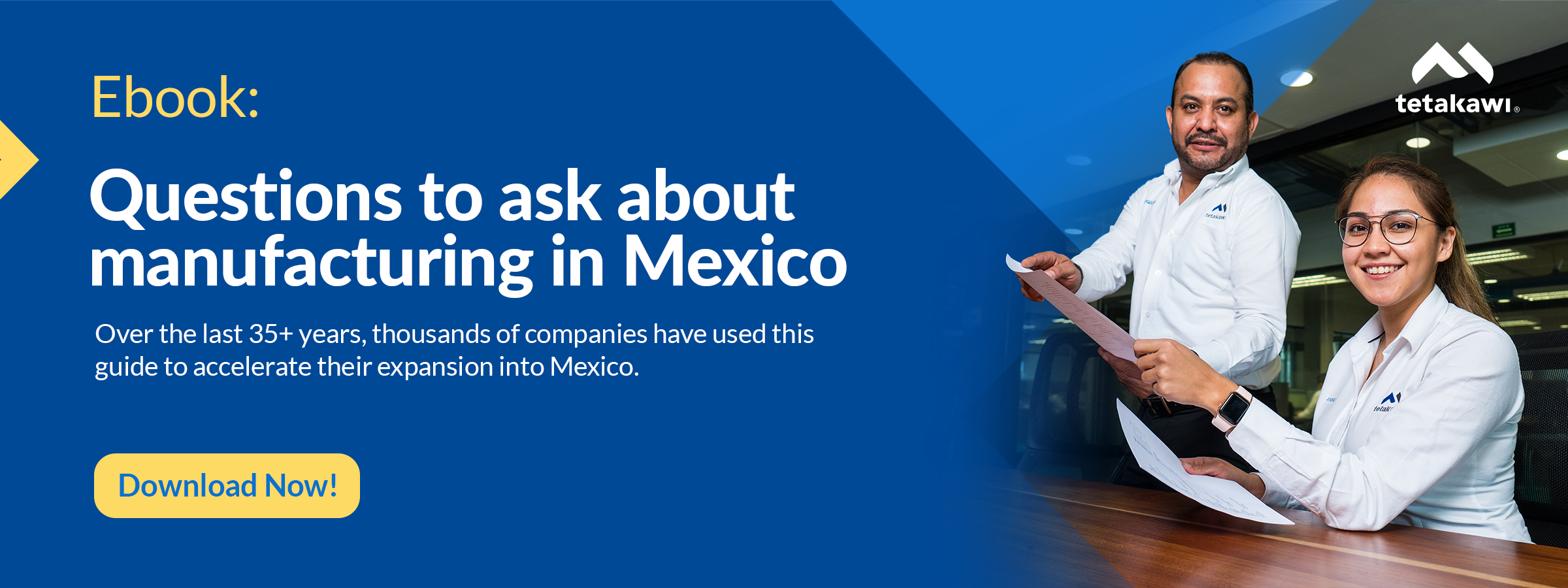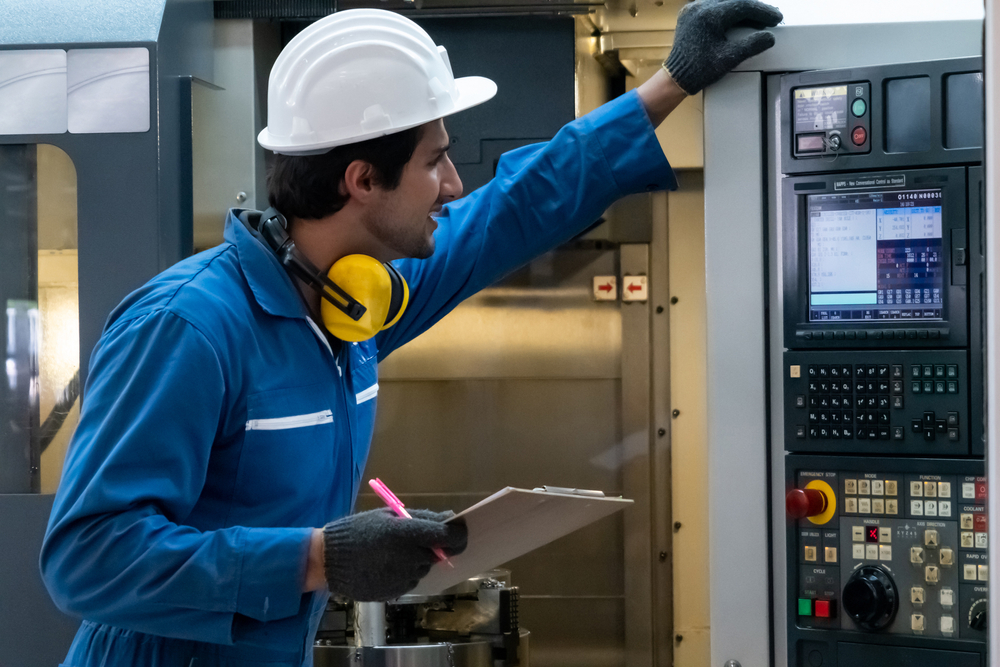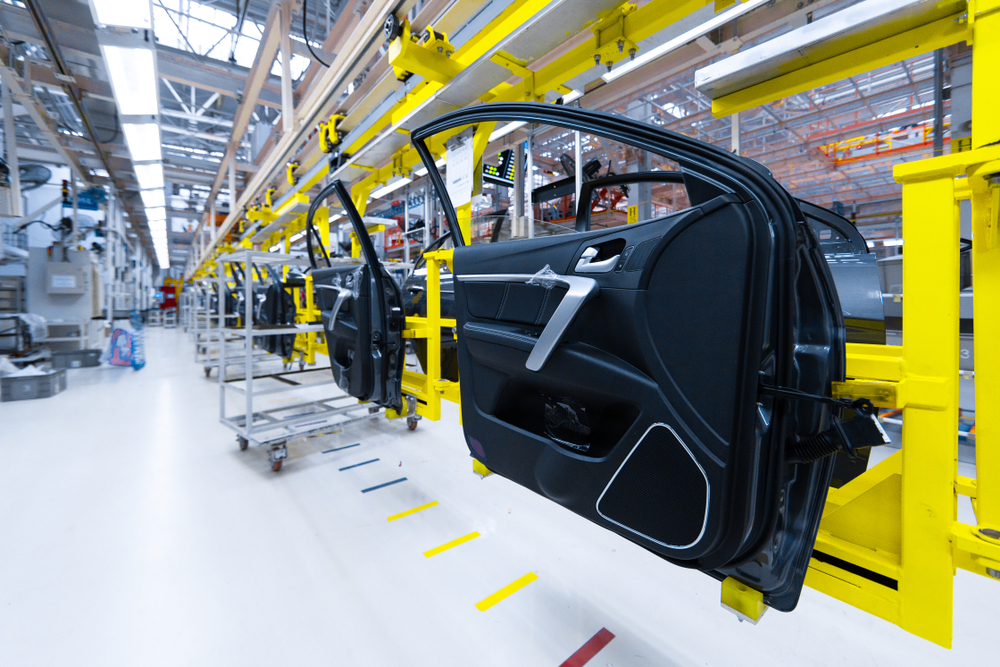IMMEX is an incentive program that provides foreign manufacturing companies an easy and cost-effective way to operate in Mexico. While the program has been around for several decades, its evolution has created some confusion around key concepts. If you need help understanding the IMMEX program or explaining the difference between an IMMEX company and a maquiladora, this article can help.
Here, we will provide a brief history behind the IMMEX program and define its key elements. We’ll also outline the various ways you can operate as an IMMEX company in Mexico and the benefits it can provide your firm.
What is the IMMEX program?
The IMMEX program is a strategic initiative that grants qualifying companies the ability to import goods into Mexico temporarily for industrial processing or to provide export services. A key advantage of this program is its substantial tax benefits, exempting temporarily imported goods from general import tax, value-added tax (VAT), and certain countervailing duties.
To reap these tax benefits, companies must use the imported goods in manufacturing or repairing products destined for export or transfer to another IMMEX-registered entity. Depending on the final product's nature, the exported goods must leave Mexico within a six to twelve-month timeframe.
The IMMEX program meticulously classifies permissible imports for registered companies into three main categories, each integral to the success of the program:
- Raw Materials and Components: This category includes raw materials, parts, and components that will be fully processed into exported goods. It also comprises items crucial to production, such as containers, packaging, and labeling materials for the exported goods.
- Transportation Materials: This group consists of shipping containers and boxes that facilitate the efficient transportation of goods.
- Machinery and Tools: This category includes machinery, tools, equipment, and other instruments crucial to production processes. Items used for quality control, research, training, associated production processes, and administrative tasks within the company also fall under this category.
By allowing these specific imports, the IMMEX program fosters a vibrant manufacturing ecosystem vital for the growth and success of businesses operating in Mexico.
What is the difference between IMMEX and maquiladoras?
In discussions about manufacturing in Mexico, you've likely heard the terms IMMEX and maquiladoras used interchangeably or together. However, understanding the difference between these two terms can provide a clearer picture of Mexico's manufacturing landscape.
Firstly, IMMEX stands for "Industria Manufacturera, Maquiladora y de Servicios de Exportación," which translates to the Manufacturing, Maquiladora, and Export Services Industry. The IMMEX program is a strategic initiative by the Mexican government that came into existence in 2006. It was developed as a result of combining two separate programs:
- The Development and Operation of the Maquila Export Industry (the maquiladora program)
- Temporary Import Programs to Produce Export Goods (PITEX)
On the other hand, a maquiladora is a term used to describe a factory in Mexico that is owned and operated by a foreign company. These factories manufacture products in Mexico and then export them to other countries. They operate under the IMMEX program, which provides several benefits like tax exemptions and duty-free importation of goods used in the manufacturing process.
In essence, the maquiladora program was integrated into the broader IMMEX program, and all maquiladoras now operate under IMMEX. This combination allows companies to take advantage of the incentives provided by IMMEX while contributing to the growth of Mexico's export industry.
So, when considering the difference, remember this: while all maquiladoras are part of the IMMEX program, not all companies under the IMMEX program are maquiladoras. Some companies under IMMEX might be involved in other export-related services, not just manufacturing. By understanding these differences, companies can better navigate Mexico's manufacturing and export sector.
What are the benefits of the IMMEX Program?
The IMMEX program is a powerful tool that offers significant benefits to foreign manufacturing companies operating in Mexico. Here are seven of the primary benefits the IMMEX companies can enjoy while manufacturing in Mexico:
-
Tax Incentives: The IMMEX program allows registered companies to temporarily import goods necessary for their industrial process or service without the burden of general import tax, VAT, or certain countervailing duties. This tax exemption can greatly reduce the cost of operation for businesses.
-
Facilitates Exportation: All imported goods under the IMMEX program must be used for manufacturing or repairing products intended for export or transfer to another IMMEX company. This supports and encourages the exportation of goods, thereby stimulating the growth of businesses and the Mexican economy.
-
Supports Foreign Direct Investment: By providing a framework that incentivizes and facilitates exports, the IMMEX program encourages foreign direct investment. This helps to expand the country's manufacturing sector and create jobs.
-
Access to Skilled Labor: Mexico has a long history of manufacturing, which has resulted in a highly skilled labor force. Companies operating under the IMMEX program can leverage this skilled labor for their manufacturing processes.
-
Geographical Advantage: For North American companies, in particular, Mexico's geographical proximity offers significant benefits. Nearshoring can balance the low labor and real estate costs with reduced shipping times.
-
Global Reach: With free trade agreements supporting trade with more than 50 countries, companies can benefit from a location in Mexico, whether or not they’re aiming to sell products in the U.S. market.
-
Supports the Entire Socioeconomic Spectrum: The IMMEX program helps to create jobs across the socioeconomic spectrum, contributing to the overall welfare of the Mexican population.
The IMMEX program is a comprehensive initiative designed to foster a robust manufacturing ecosystem in Mexico. With its wide array of benefits, it presents a compelling case for foreign manufacturing companies to consider establishing operations in Mexico.
How has IMMEX improved U.S.-Mexico Relations?
The IMMEX program has not only played a pivotal role in strengthening the economic relationship between Mexico and the United States but has also proven to be mutually beneficial for both nations. Here's an exploration of the broader impacts of this program.
-
Boosting Trade: The IMMEX program has been instrumental in positioning Mexico as a key player in the world of manufactured exports, with a vast majority of these exports - to the tune of $326 billion - destined for the United States. This robust trade relationship serves to bolster the economic ties between the two nations.
-
Job Creation: The IMMEX program was introduced by the Mexican government in 1965 with an aim to mitigate unemployment issues along its northern border. By providing incentives for U.S. companies to establish manufacturing units in Mexico, it has not only created jobs in Mexico but also in the U.S., given the intertwined supply chains and business services.
-
Attracting U.S. Investment: The IMMEX program, offering tax and duty-free benefits along with access to affordable, skilled labor, has attracted significant U.S. investment. This influx of investment has not only stimulated the Mexican economy but also led to the creation of jobs and business opportunities in the U.S., further strengthening the economic interdependence of the two countries.
-
Influence of NAFTA and USMCA: The economic synergy between Mexico and the U.S. was further bolstered by the North American Free Trade Agreement (NAFTA) and its successor, the United States-Mexico-Canada Agreement (USMCA). These agreements facilitated increased trade and cooperation, thereby strengthening the economic ties fostered by the IMMEX program.
-
Nearshoring Advantage: Comparing Mexico and China as manufacturing destinations, the IMMEX program gives Mexico a strategic advantage due to its proximity to the U.S. The reduced shipping times and logistical challenges make Mexico a preferred choice for U.S. companies, benefiting the U.S. economy by ensuring more efficient supply chains.
-
Job Creation in the U.S.: By encouraging U.S. companies to establish manufacturing plants in Mexico, the IMMEX program indirectly leads to job creation in the U.S. These jobs are created in areas such as logistics, administration, design, and sales that support the manufacturing activities in Mexico.
-
Economic Stability: By fostering a robust trade relationship with Mexico, the U.S. can secure a stable economic partner and decrease its reliance on distant economies like China. This not only benefits the U.S. economy through reduced costs and supply chain risks but also contributes to regional economic stability.
Through its profound influence on trade, investment, and job creation, the IMMEX program epitomizes how strategic economic policies can shape robust bilateral relationships. By fostering a win-win scenario for both Mexico and the United States, it has played a pivotal role in enhancing the economic ties between these two neighbors.
What are the IMMEX Program requirements?
Starting a maquiladora or a foreign-run factory in Mexico begins with obtaining an IMMEX registration. The IMMEX program, designed to incentivize foreign direct investment, is open to companies that meet certain criteria. Here are the primary requirements that companies must fulfill to obtain an IMMEX registration:
-
Export Threshold: Companies must demonstrate annual foreign sales of at least USD 500,000 or export invoices that account for at least 10% of the company's total invoices. This requirement ensures that the IMMEX program supports businesses with a substantial international presence.
-
Business Registration: Companies must apply for IMMEX registration through an office of the Secretariat of Economy in the Mexican state where they plan to operate. This step involves filling out an application and providing several supporting documents, such as an active Federal Taxpayer Registration.
-
Documentation: The necessary supporting documents can vary depending on the specific type of IMMEX company being established. Detailed annual reports are also a requirement for maintaining an IMMEX registration. These reports must comply with specific and comprehensive requirements, illustrating a company's ongoing compliance with the program's objectives.
-
Time Commitment: It's important to note that obtaining an IMMEX registration can be a lengthy process. Securing the registration and necessary permits can take anywhere from six to twelve months or even longer. This timeline reflects the thoroughness of the registration process and the commitment required to operate within the IMMEX program.
Many companies seeking a quicker entry into the Mexican market opt to partner with a shelter service provider. These providers can streamline the process and help businesses navigate the complexities of IMMEX registration and operation.
In sum, obtaining an IMMEX registration requires a combination of demonstrating a certain level of foreign sales, completing the necessary documentation, maintaining ongoing compliance, and exercising patience. This process, while rigorous, can open up significant opportunities for companies in the Mexican manufacturing sector.
What are the different types of IMMEX registrations?
An IMMEX company is a foreign entity that is registered under the IMMEX program through Mexico's Department of Economy. IMMEX registration can be obtained in one of five distinct categories:
-
Holding Company IMMEX: Under this category, the holding company holds the IMMEX registration, which covers its own manufacturing operations as well as those of one or more of its subsidiaries.
-
Industrial IMMEX: This type of registration is granted to manufacturing companies that import goods for use in an industrial process with the aim of producing goods for export.
-
Services IMMEX: Service companies that support the export of relevant goods under IMMEX registration fall under this category. This includes legal entities, software developers, recyclers, and certain other service companies.
-
Shelter IMMEX: A Shelter IMMEX is a Mexican company that serves as a legal entity, assuming all legal risk and liability for manufacturers operating under its IMMEX registration.
-
IMMEX Outsourcing Program or Third-Party IMMEX: In situations where a certified company does not own the necessary facilities to perform its production processes, it can manufacture through a third party that it registers in its program.
In summary, an IMMEX company is a foreign enterprise that operates under Mexico's IMMEX program, making use of the program's benefits to facilitate its manufacturing processes and export operations.
Which industries use the IMMEX Program?
The IMMEX program has been instrumental in fueling a broad array of industries, with automotive manufacturing leading the charge. In 2020, Mexico produced nearly 4 million vehicles, making it the sixth-largest automobile producer worldwide. This massive production scale is largely geared towards export, with a significant 90% of vehicles manufactured for foreign markets. Remarkably, the United States receives 79% of these exports, highlighting the close trade ties between the two nations.
Yet, the impact of the IMMEX program extends far beyond the automotive industry. The vast expertise accumulated in this sector has served as a solid foundation for the development of related industries. For instance, computers, Mexico's second most significant export category, offer a glimpse into the country's thriving electronics production sector.
The IMMEX program also bolsters various other manufacturing sectors. These include, but are not limited to:
-
Aerospace: The IMMEX program supports the aerospace industry's growth by enabling the import of parts and materials for aircraft manufacturing without incurring taxes, thus making Mexico an attractive destination for aerospace manufacturing companies.
-
Medical Devices: Mexico's medical device manufacturing industry has experienced significant growth, facilitated by the IMMEX program's tax benefits and duty-free import of materials necessary for the production of these devices.
-
Appliances: The appliance industry, including the production of household items like refrigerators, dishwashers, and washing machines, greatly benefits from the IMMEX program by being able to import raw materials tax-free, leading to more cost-effective production.
-
HVAC (Heating, Ventilation, and Air Conditioning): The HVAC industry in Mexico, manufacturing products such as air conditioners, heaters, and ventilation systems, is another beneficiary of the IMMEX program, taking advantage of the cost savings from duty-free imports.
-
Furniture: With the IMMEX program, furniture manufacturers can import raw materials, such as wood and metal, duty-free, supporting the production of high-quality furniture for export.
-
Plastics: The plastics industry, producing a wide range of goods from packaging materials to automotive parts, can import raw materials without taxes under the IMMEX program, thus supporting its growth.
-
Textiles: The IMMEX program facilitates the import of raw materials for the textile industry, making Mexico a competitive player in the global textile and apparel market.
In summary, the IMMEX program provides substantial support to a wide array of industries in Mexico, allowing them to flourish and compete effectively on the global stage.
Where are most maquiladoras located in Mexico?
The majority of maquiladoras in Mexico are strategically situated in specific regions, particularly along the border with the United States. This proximity offers numerous advantages in terms of logistics, transportation, and trade facilitation. Here are the main locations where most maquiladoras are concentrated:
-
Baja California: Located in the northwest of Mexico, Baja California is home to maquiladoras in cities like Tijuana and Mexicali. Tijuana, in particular, has a robust maquiladora industry and serves as a vital manufacturing hub.
-
Chihuahua: This state in northern Mexico is another prominent location for maquiladoras. Cities such as Ciudad Juarez and Chihuahua City attract a significant number of manufacturing operations due to their proximity to the U.S. border.
-
Sonora: Bordering the U.S. states of Arizona and New Mexico, Sonora is an attractive location for maquiladoras. Cities like Hermosillo, Guaymas, and Empalme have a strong presence of manufacturing facilities, offering strategic access to both the U.S. and Pacific markets.
-
Coahuila: Coahuila, located in the northern part of Mexico, is known for its industrial activity. Major cities like Saltillo and Ramos Arizpe are important centers for automotive and aerospace manufacturing.
-
Nuevo Leon: With its capital city of Monterrey, Nuevo Leon is a thriving industrial region and home to a significant number of maquiladoras. The state boasts a diverse manufacturing sector, including automotive, electronics, and appliances.
-
Tamaulipas: Situated along the U.S.-Mexico border, Tamaulipas is an attractive location for maquiladoras due to its proximity to major U.S. cities. Cities like Reynosa and Matamoros have a substantial presence of manufacturing operations.
-
Queretaro: While not located directly on the border, Queretaro has emerged as a notable destination for maquiladoras in central Mexico. The state offers a favorable business environment and a skilled workforce, attracting industries such as aerospace, automotive, and electronics manufacturing.
While the states mentioned above play a significant role in hosting maquiladoras, it is important to acknowledge the evolving landscape of manufacturing in Mexico. Traditionally, maquiladoras have been concentrated along the border regions, capitalizing on their proximity to the United States. However, the industry is undergoing a transformation as labor shortages and increasing wages along the border compel companies to consider manufacturing locations in the interior of Mexico.
This shift is driven by the need to address labor challenges and seek cost efficiencies. As labor markets tighten along the border, companies are exploring opportunities in the interior regions of Mexico, where there is a larger labor pool available. By tapping into these regions, manufacturers can overcome labor shortages and access a skilled workforce.
Do you need a partner in Mexico to set up maquiladora?
A manufacturer does not need a Mexico-based partner to benefit from the IMMEX program. However, many companies choose to operate a maquiladora under the umbrella of a shelter services company. This offering is one more way that Mexico simplifies the process of launching a manufacturing operation.
A shelter service company is a service provider that allows a foreign company to conduct its business in Mexico under the Mexico-based company’s IMMEX registration. Through this arrangement, the IMMEX company serves as the legal entity in Mexico and assumes all liability. The shelter company also manages the legal and administrative tasks related to the business. The foreign company retains complete control over manufacturing.
Experienced shelter companies are able to easily navigate the red tape required to get manufacturers up and running fast. Foreign companies are often able to select the amount of support they need.
If you’re ready to take advantage of the IMMEX Program, Tetakawi can help. Reach out to discuss your options today.
Subscribe
Sign up and stay informed with tips, updates, and best practices for manufacturing in Mexico.
Table of Contents:
- What is the IMMEX program?
- What is the difference between IMMEX and maquiladoras?
- What are the benefits of the IMMEX Program?
- How has IMMEX improved U.S.-Mexico Relations?
- What are the IMMEX Program requirements?
- What are the different types of IMMEX registrations?
- Which industries use the IMMEX Program?
- Where are most maquiladoras located in Mexico?
- Do you need a partner in Mexico to set up a maquiladora?






